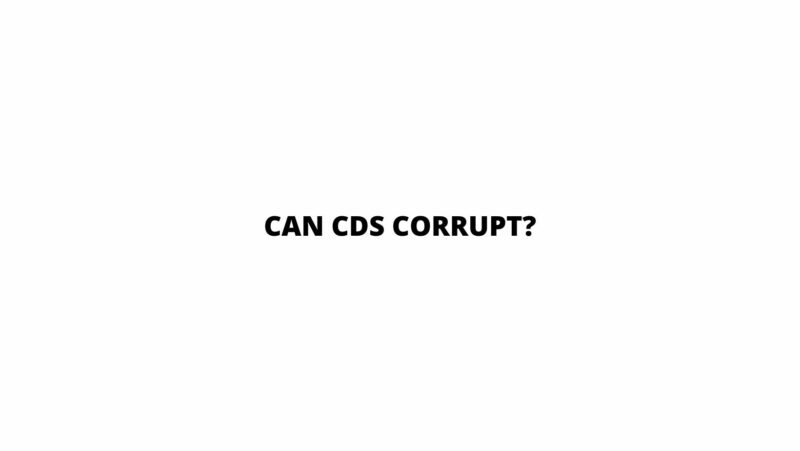Compact Discs (CDs) have long been a staple in our digital lives, serving as a reliable means of storing and accessing audio content. However, the question arises: can CDs really corrupt? This article delves into the complexities of CD technology, explores the potential factors that contribute to CD corruption, addresses misconceptions, and offers insights into understanding the truth behind the concept of CD corruption.
Demystifying the CD Universe
CD Composition: A CD consists of layers, including a polycarbonate substrate, a reflective layer (often aluminum), a data layer containing microscopic pits and lands, and a protective layer.
Reading Mechanism: CD players employ lasers to read the data encoded on the disc’s surface. The laser’s reflection off the pits and lands generates digital signals that are transformed into audio or data.
Exploring the Possibility of CD Corruption
1. Physical Damage:
- Scratches: Deep scratches can alter the laser’s trajectory, leading to misread data.
- Fingerprints and Smudges: Oils from fingerprints or smudges can impact the laser’s reading accuracy, resulting in playback errors.
- Dust and Debris: Particles on the disc’s surface can create obstructions that interfere with data retrieval.
2. Environmental Influences:
- Sunlight Exposure: Extended exposure to direct sunlight can degrade the disc’s protective layer, potentially leading to corruption.
- Temperature and Humidity: Extreme temperature and humidity fluctuations can cause warping or deterioration of the disc’s layers.
3. Chemical Interactions:
- Oxidation: Over time, exposure to air can trigger oxidation of the reflective layer, affecting the laser’s reflection and data accuracy.
4. Manufacturing Flaws:
- Pit and Land Inaccuracies: Manufacturing errors can lead to misaligned pits and lands, contributing to reading errors.
- Reflective Layer Quality: Poorly applied or uneven reflective layers can impact laser reflection and reading precision.
5. Wear and Tear:
- Laser Lens Degradation: The laser lens within CD players can degrade with use, diminishing its ability to accurately read data.
- Mechanical Wear: Frequent insertion and removal of CDs can lead to mechanical wear on the disc’s surface and player components.
6. Copy Protection and DRM:
- Copy Protection Schemes: Certain copy protection mechanisms intentionally create unreadable sections on the disc, potentially leading to corruption.
- DRM Challenges: Digital Rights Management (DRM) measures may introduce compatibility issues that contribute to potential corruption on specific devices.
Analyzing the Notion of CD Corruption
- Physical Damage: Accidental mishandling, exposure to rough surfaces, or improper storage conditions can result in physical damage that could potentially corrupt a CD’s data.
- Environmental Factors: Extended exposure to sunlight, extreme temperatures, and high humidity levels can weaken the structural integrity of CDs and potentially lead to corruption.
- Contaminants: Dust, dirt, and foreign particles settling on the CD’s surface can hinder the laser’s path and introduce errors, potentially causing corruption.
- Chemical Reactions: Oxidation triggered by exposure to air and moisture can impact the CD’s reflectivity, potentially contributing to data corruption.
- Wear from Usage: Repeated insertion and removal of the CD from the player can result in wear on the disc’s surface and the player’s mechanisms, potentially affecting data reading.
Mitigation and Preservation Strategies
- Proper Handling: Holding CDs by the edges and avoiding direct contact with the playing surface can prevent smudges, fingerprints, and scratches.
- Storage Conditions: Storing CDs in protective cases or sleeves when not in use shields them from environmental contaminants.
- Sunlight Avoidance: Protecting CDs from direct sunlight and extreme temperature fluctuations can help prevent damage and potential corruption.
- Regular Cleaning: Gently cleaning CDs using a soft, lint-free cloth and wiping from the center to the edges can prevent buildup that might hinder data reading.
- Backup Copies: Creating digital backup copies of essential CDs can serve as insurance against potential corruption.
- Digital Conversion: Converting CDs to digital formats ensures long-term preservation and easy access to content.
- Professional Restoration: Seeking professional disc restoration services for scratched or damaged CDs can help salvage corrupted data.
Conclusion
While the idea of CDs succumbing to corruption is not unfounded, it’s essential to approach this concept with a balanced perspective. CDs, like any technology, are susceptible to various influences that can impact their integrity, including physical damage, environmental factors, and wear. However, the notion that CDs will inevitably corrupt is not accurate. By taking preventive measures and adopting proper handling, storage, and cleaning practices, users can significantly reduce the likelihood of corruption. Understanding the complexities of CD technology empowers us to make informed choices and enjoy the benefits of this durable and iconic digital medium for years to come.


